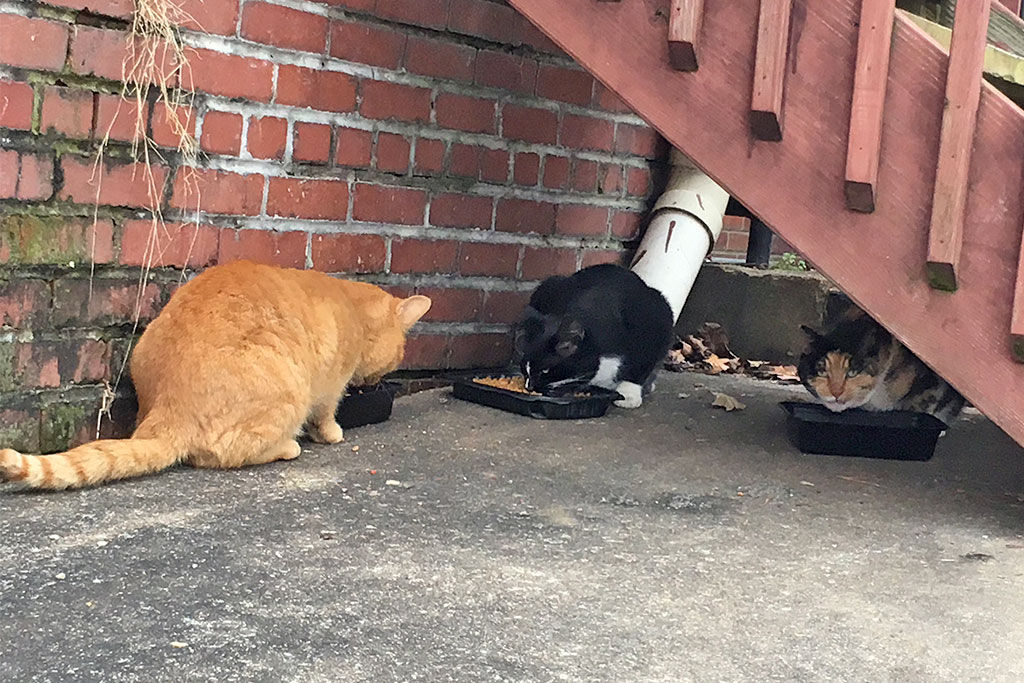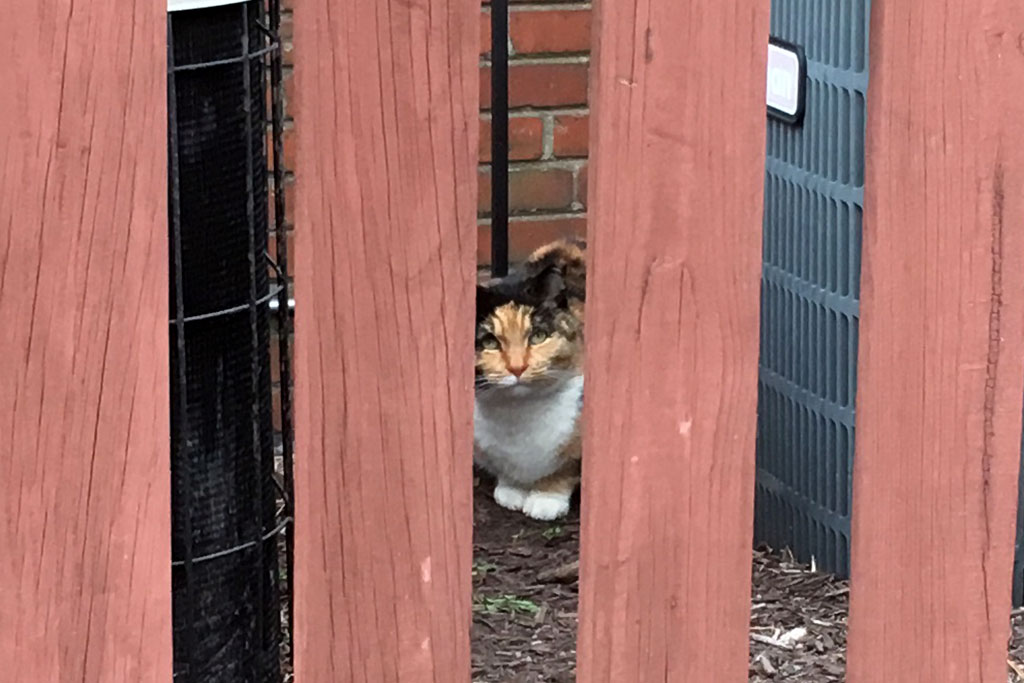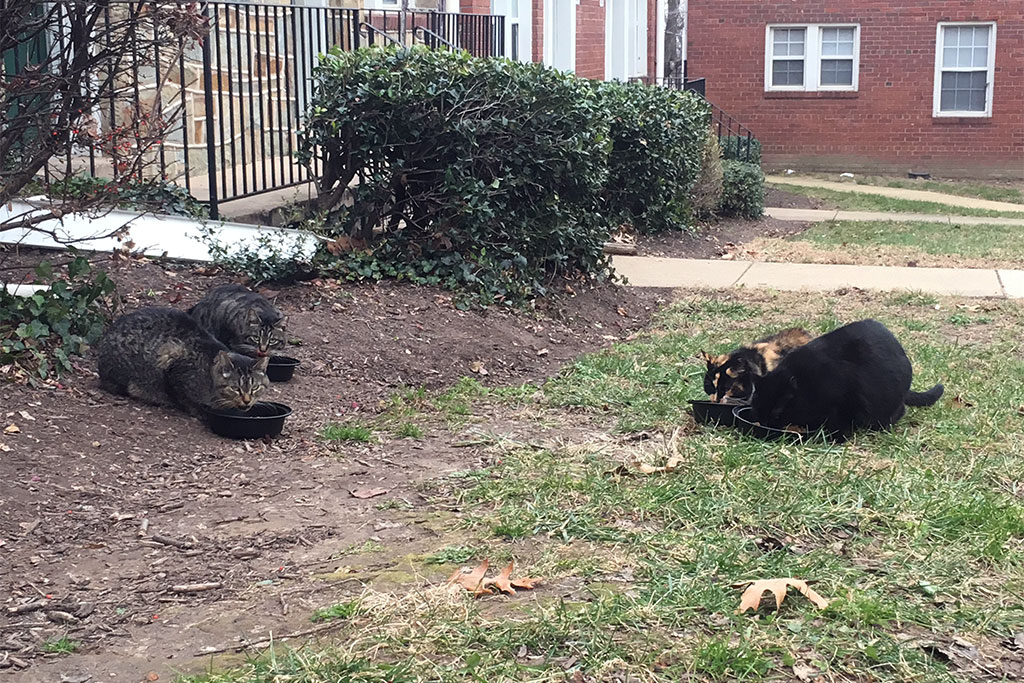The following feature article was written by Buzz McClain, a writer and communications professional who lives in Arlington. It was funded by our new Patreon community. Want to see more articles like this, exploring important local topics that don’t make our usual news coverage? Join and help fund additional local journalism in Arlington.
A feral cat is a cat that lives in the wild without human intervention, and Arlington has plenty of them.
Along with coyotes, foxes, rabbits — so many rabbits — turtles, snakes, and other fauna that share the county with humans, feral cats have established “colonies” throughout Arlington, some of which date back for generations.
At any given time there are some 200 to 250 feral cats in Arlington, with colonies ranging in size from two to three cats to more than a dozen. There seems to be a concentration of colonies around Columbia Pike and Carlin Springs Road and in the Nauck neighborhood, according to Anna Barrett, an animal services coordinator with the Animal Welfare League of Arlington, the private nonprofit organization that provides shelter and animal control services in the county.
Feral cats are easy to spot, she said. For one, they are unapproachable, so if they see you first, chances are they’ll run and hide. You can’t lure them to your hand or into a trap, not even with food. “They’re more like wildlife than a domestic cat,” she said.
They also may have a section of an ear removed. A clipped ear, Barrett said, is an indication that the cat has been trapped, neutered, inoculated for rabies and distemper, “ear-tipped” to indicate treatment, and returned to where it was found as part of the AWLA program of the same name: Trap-Neuter-Return. (See here for the feral cat program page of the AWLA website.)
AWLA personnel do not do the trapping, and they don’t accept feral cats as strays for adoption — they are not safe for the staff to handle. Feral cats cannot be domesticated, and handling them may lead to injury, to humans as well as cats.
But feral cat colony “caretakers,” and the occasional determined resident, manage to bring them in. That’s when the AWLA staff does the T-N-R and ear clip service. The feral cat colony caretaker who brought in the cat is responsible for returning them to where they were found, which is why it’s best for those unfamiliar with feral cat behavior to not even try.
In her eight years at the shelter, Barrett has seen a reduction in the feral cat population. “We feel the 200 to 250 number is greatly reduced from year’s past, in large part to the T-N-R program,” she said.
The T-N-R program, she added, “is not a perfect solution, but it goes with our humane approach to animals.”
The neutering would cost $300 to $400 per cat for a pet cat or kitten. The League pays for cats trapped in Arlington or in the City of Falls Church.
The cats, said Sandra M., choose her and not the other way around. And it’s been that way for going on eight years.
After her own cat died in 2010, an “outdoor” Siamese cat tentatively approached her at her home in South Arlington and Sandra M., a cat lover, fed it. (She would rather we did not use her full name or specify which neighborhood she lives in, for reasons that will become obvious.)
The cat was healthy but clearly did not have a home, nor did it seem to crave human companionship other than the occasional meal. Eight years later, the cat still comes for regular feeding but little else, along with some eight other cats.
They do not go into her house. Instead, they live nearby in the wild in what is known as a feral cat colony, one of many in Arlington, some of which date back for decades.
Sandra M. is a feral cat colony caretaker, an unofficial title given to a select few by the AWLA. But not everyone is enamored with having feral cats in their neighborhoods. Sandra M. reports several of her charges have been mistreated after being captured. Kittens and older cats have been poisoned.
“That’s something I just don’t understand,” she said. “I don’t understand why a human would do that.”
For Sandra M., the cat colony is a blessing. “They rescued me,” she said. “They’re like little children to me.”
If you see a cat you think is feral, Anna Barrett suggests contacting the AWLA office to report it. A feral cat colony caretaker may be able to have the cat serviced in the Trap-Neuter-Release program. Questions may be directed at [email protected] or by calling 703-931-9241, ext. 200.




